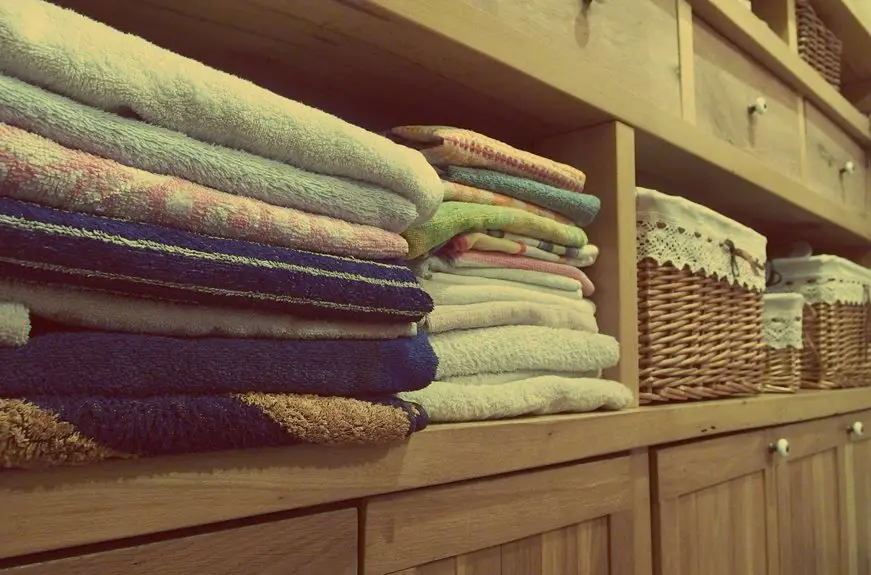You use Kevlar fabric sheets in industries like protective gear, automotive, aerospace, and construction because of their unmatched strength and lightweight durability. When cutting, handle them with sharp tools and gloves to avoid fiber damage. Store sheets flat or loosely rolled, in cool, dry places away from sunlight and moisture to maintain quality. Watch for fraying or discoloration as signs it’s time for replacement. Keep exploring to discover more tips and applications for Kevlar’s impressive benefits.
Table of Contents
Key Takeaways
- Kevlar fabric sheets are widely used in protective gear, automotive parts, aerospace components, sporting goods, and construction reinforcement.
- Their exceptional strength and impact resistance make them ideal for safety-focused applications requiring lightweight durability.
- Cut Kevlar slowly with sharp tools or a hot knife and wear gloves to avoid fiber damage and irritation.
- Store Kevlar sheets flat or loosely rolled in cool, dry, shaded areas with breathable covers to prevent damage and degradation.
- Replace Kevlar materials showing frayed edges, discoloration, stiffness, or surface damage to maintain safety and performance.
Common Industries Utilizing Kevlar Fabric Sheets
Although Kevlar fabric sheets might seem specialized, many industries rely on them for their strength and durability.
Kevlar fabric sheets are trusted across industries for unmatched strength and durability.
When you handle protective gear manufacturing, you’ll find Kevlar essential for bulletproof vests and helmets. In the automotive industry, you use it to reinforce tires and body panels, enhancing safety and performance.
Aerospace professionals depend on Kevlar fabric sheets to build lightweight, impact-resistant components. You’ll also see them in sporting goods, like racing sails and protective gloves, where toughness matters.
Even in the construction sector, Kevlar helps reinforce concrete and improve structural integrity.
When you work across these fields, Kevlar’s versatility makes it a reliable choice, supporting safety and durability without adding unnecessary weight or bulk.
Key Benefits of Using Kevlar in Manufacturing
When you incorporate Kevlar into your manufacturing processes, you gain access to exceptional strength without sacrificing weight. This material stands out because it’s lightweight yet incredibly durable, making your products both sturdy and easy to handle.
Here are three key benefits you’ll notice:
- Enhanced Safety: Kevlar’s superior impact resistance helps protect users in hazardous environments.
- Longevity: Products made with Kevlar resist wear and tear, reducing replacement frequency and costs.
- Design Flexibility: Its versatility allows you to innovate with complex shapes and applications without compromising strength.
Techniques for Cutting and Handling Kevlar Fabric
Mastering the right techniques for cutting and handling Kevlar fabric is essential to maintain its strength and integrity.
When cutting, use sharp scissors or rotary cutters designed for heavy fabrics to achieve clean edges without fraying. Always cut slowly and steadily to avoid damaging the fibers. You can also use a hot knife, which melts the edges slightly, preventing unraveling.
When handling Kevlar, wear protective gloves to avoid irritation from the fabric’s rough texture. Support the fabric fully during cutting and sewing to prevent distortion. Keep your workspace clean to avoid contamination with dirt or oils that could weaken the fibers.
Following these techniques guarantees your Kevlar sheets retain their protective qualities and perform effectively in your projects.
Best Practices for Storing Kevlar Sheets
Handling Kevlar fabric carefully during cutting and sewing helps maintain its strength, but how you store the sheets also plays a big role in preserving their quality.
To keep your Kevlar sheets in top condition, follow these best practices:
- Keep them flat or rolled: Store sheets flat or loosely rolled to prevent creases or permanent folds, which can weaken fibers.
- Avoid moisture and sunlight: Store in a cool, dry place away from direct sunlight to prevent degradation from UV rays and humidity.
- Use breathable covers: Protect sheets with breathable fabric covers instead of plastic to allow air circulation and avoid trapping moisture.
Signs of Wear and When to Replace Kevlar Material
Recognizing signs of wear in Kevlar material is essential to guarantee safety and maintain performance. You should regularly inspect your Kevlar sheets for visible damage or changes in texture. Look for fraying, discoloration, or stiff areas that indicate weakening fibers. If you notice any of these signs, it’s time to replace the material to avoid failure during use.
| Sign of Wear | What to Look For |
|---|---|
| Fraying Edges | Loose or unraveling fibers |
| Discoloration | Yellowing or dark spots |
| Stiffness | Loss of flexibility in fabric |
| Surface Damage | Cuts, holes, or abrasions |
Frequently Asked Questions
Can Kevlar Sheets Be Dyed or Printed On?
You can’t easily dye Kevlar sheets because their fibers resist most dyes. However, you can print on them using specialized inks or techniques designed for synthetic materials, ensuring the print adheres without damaging the fabric’s strength.
What Are the Environmental Impacts of Kevlar Production?
You should know Kevlar production uses energy-intensive processes and hazardous chemicals, which can impact air and water quality. However, advancements aim to reduce waste and emissions, making its environmental footprint gradually smaller over time.
How Does Kevlar Compare to Other Aramid Fibers?
Like a champion runner, Kevlar outperforms many aramid fibers with its exceptional strength-to-weight ratio, heat resistance, and durability. You’ll find it tougher and more versatile, making it a top pick for protective gear and industrial uses.
Are Kevlar Sheets Recyclable or Biodegradable?
Kevlar sheets aren’t biodegradable because they’re synthetic fibers. Recycling them is tricky since they’re tough and heat-resistant, but specialized programs exist. You’ll need to check locally for facilities that handle Kevlar recycling properly.
What Safety Precautions Are Needed When Disposing of Kevlar?
Did you know Kevlar fibers can irritate your skin like fiberglass? When disposing of Kevlar, wear gloves and a mask to avoid irritation. Also, follow local hazardous waste guidelines since it’s not biodegradable or easily recyclable.
- Does Chiffon Fabric Stink - July 15, 2025
- Does Chiffon Fabric Affect the Economy - July 15, 2025
- Does Cotton Fabric Have a Nap - July 15, 2025







